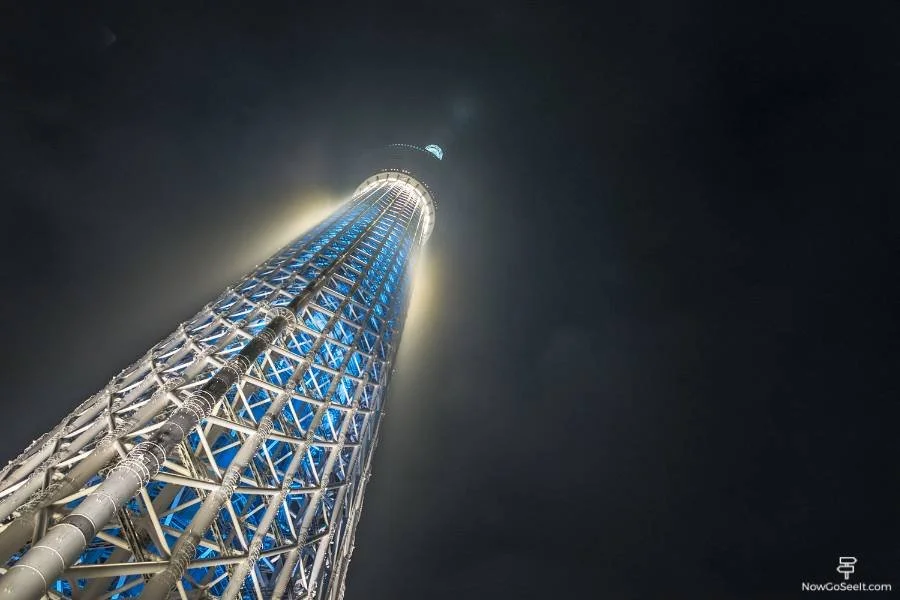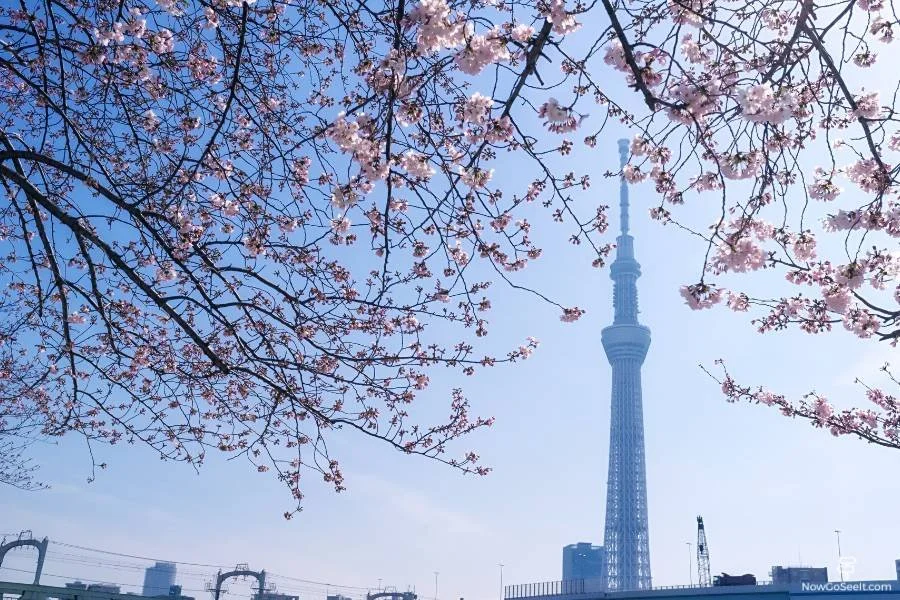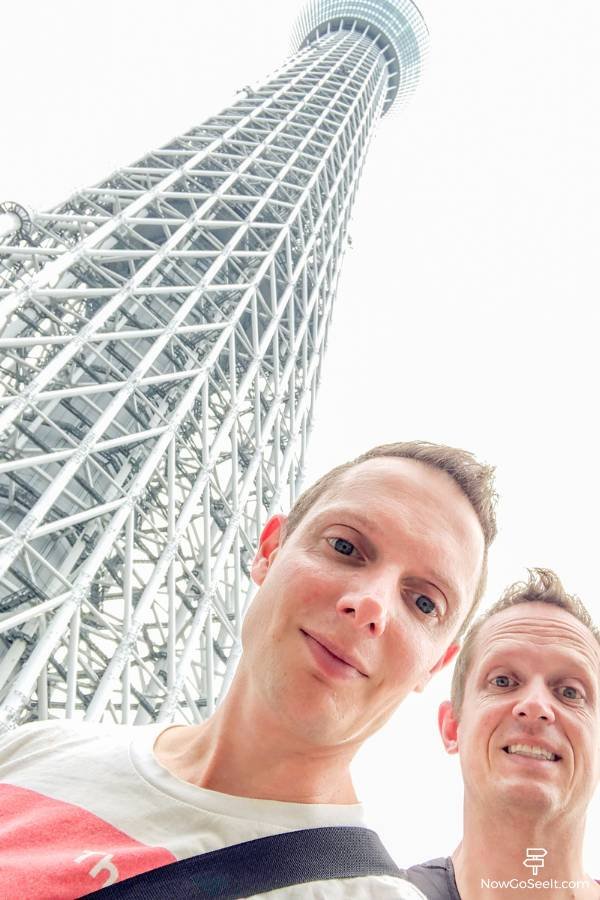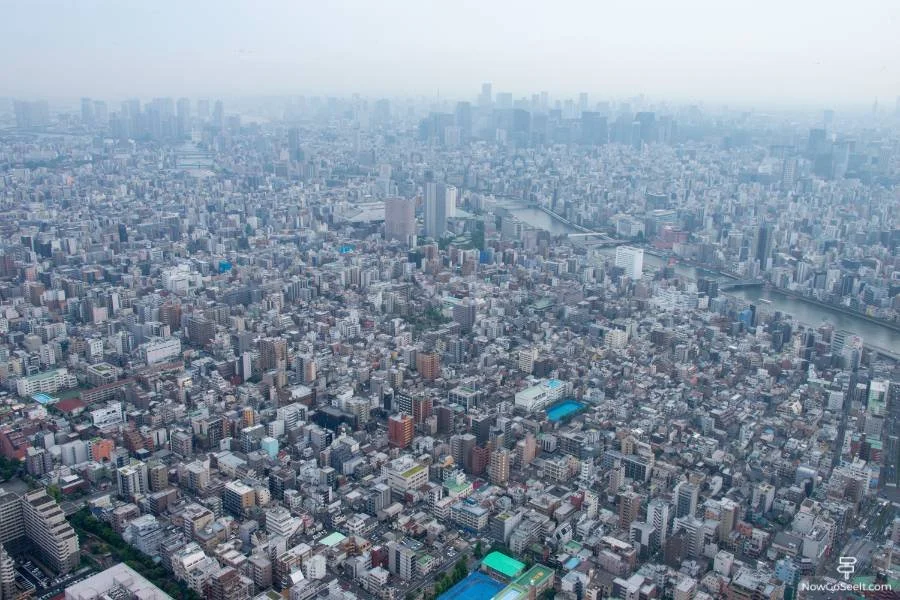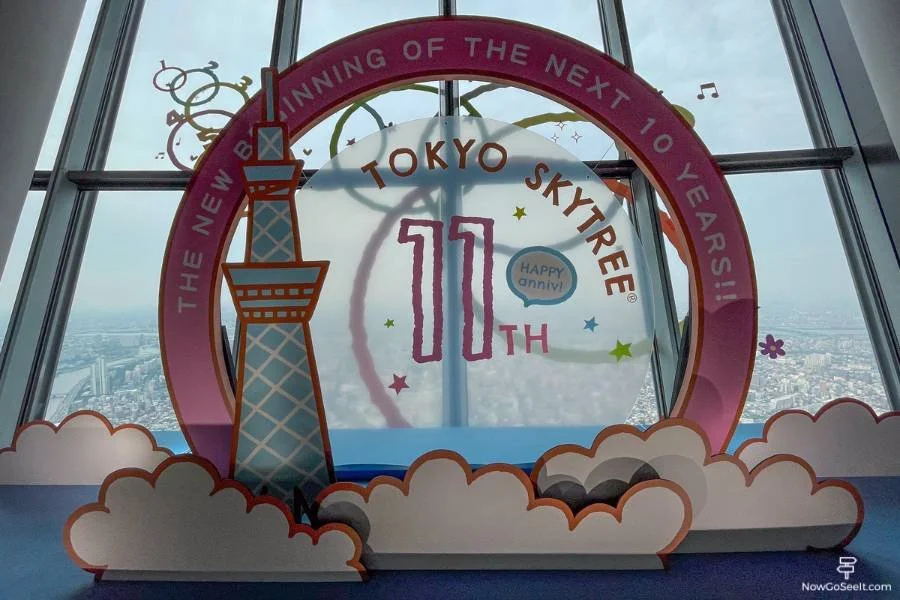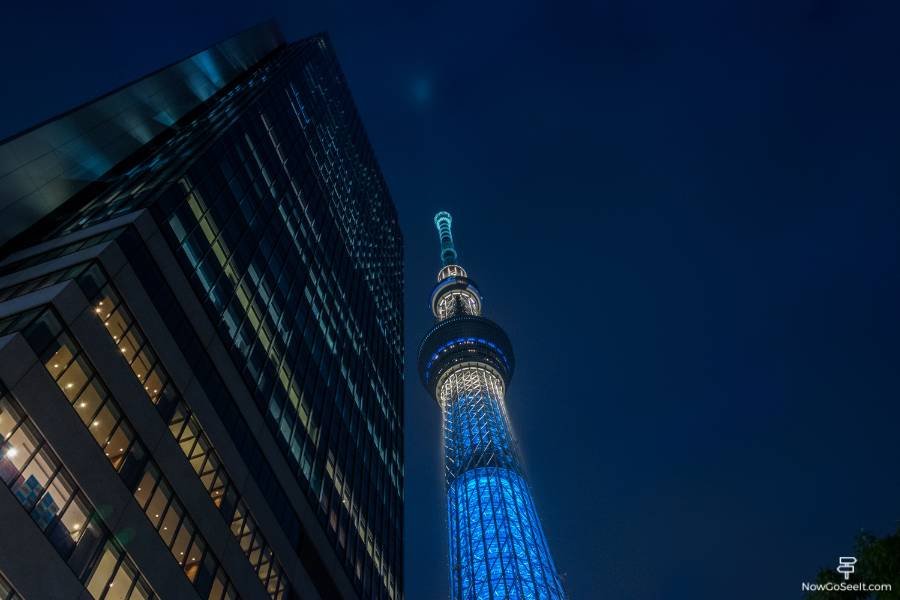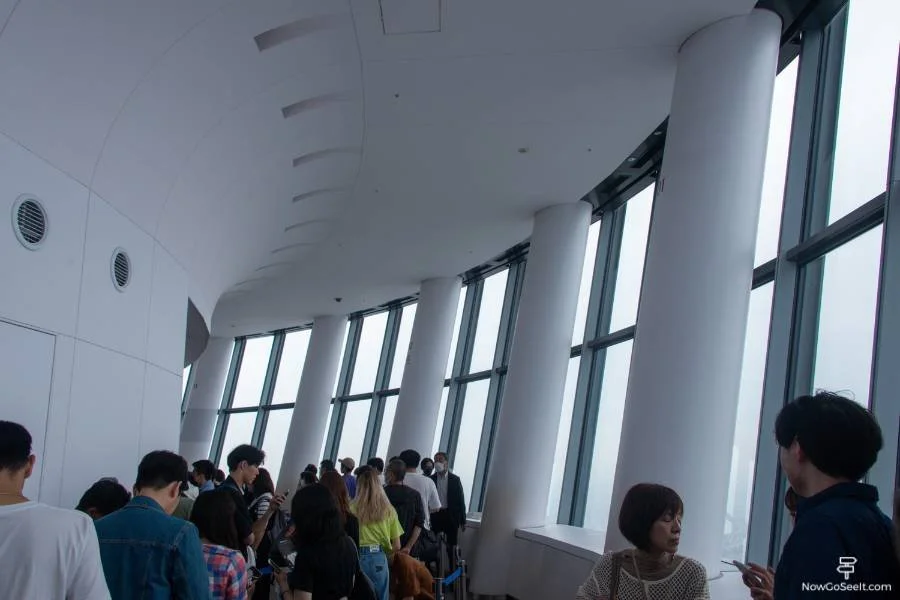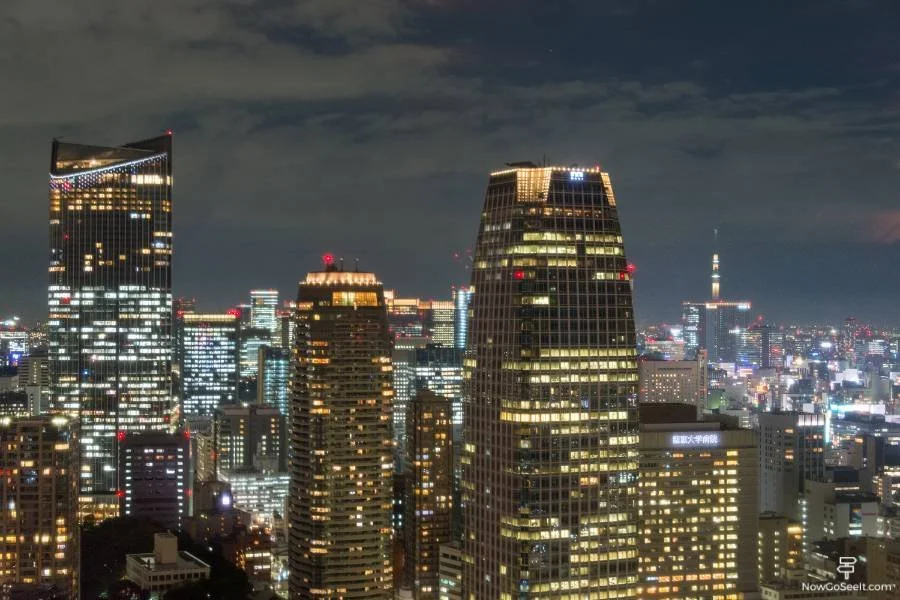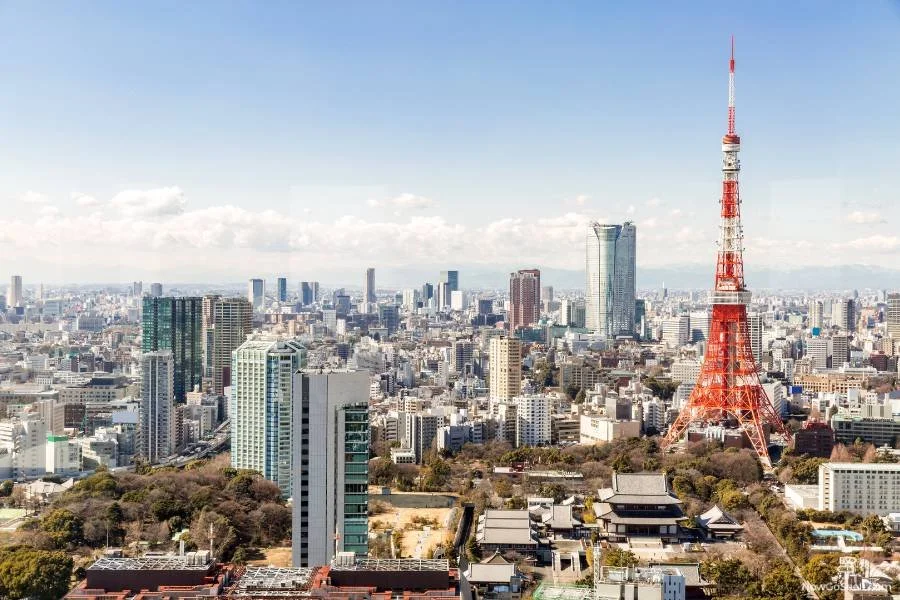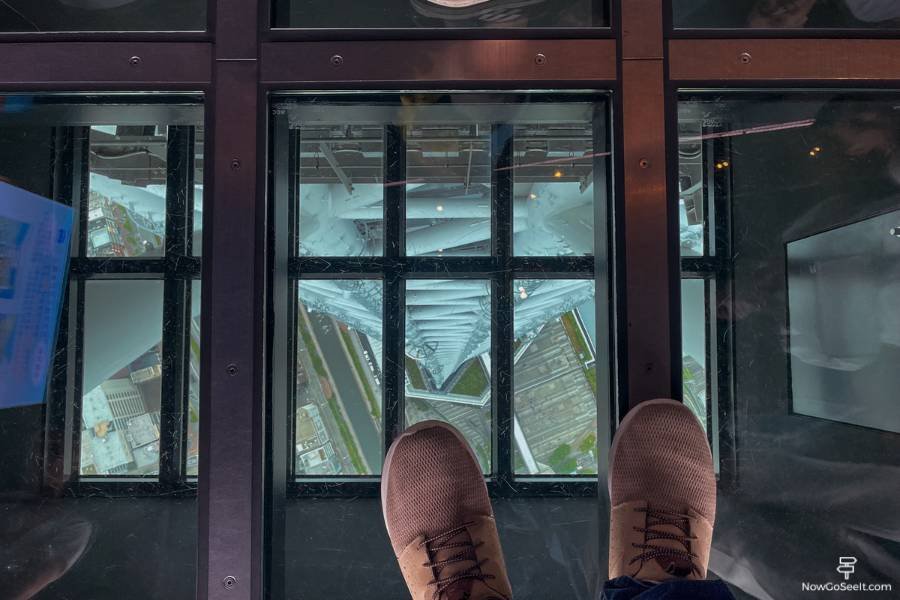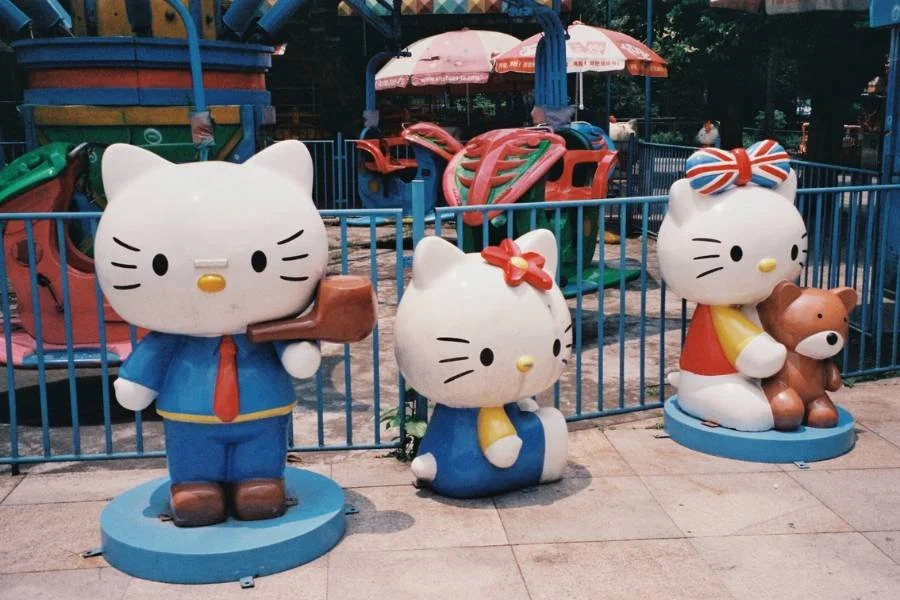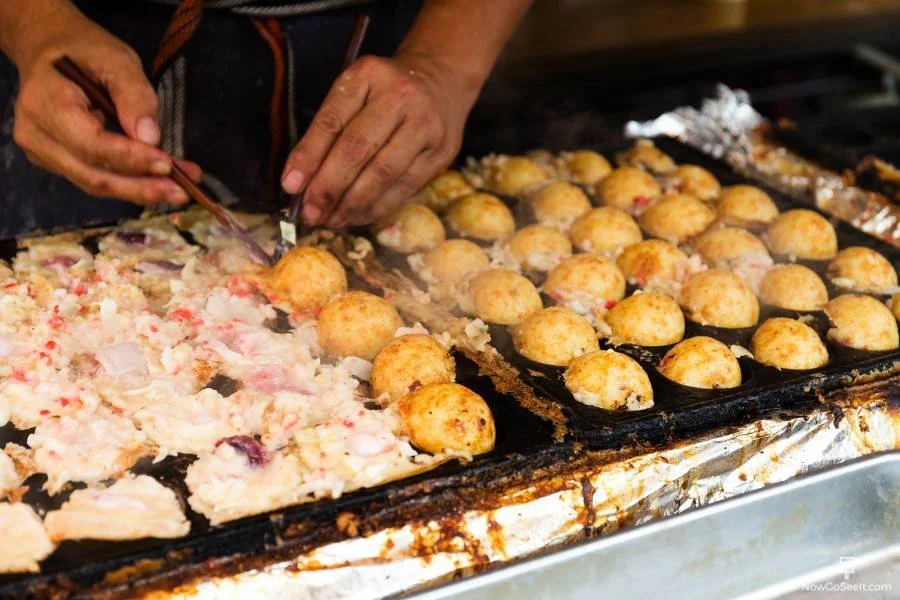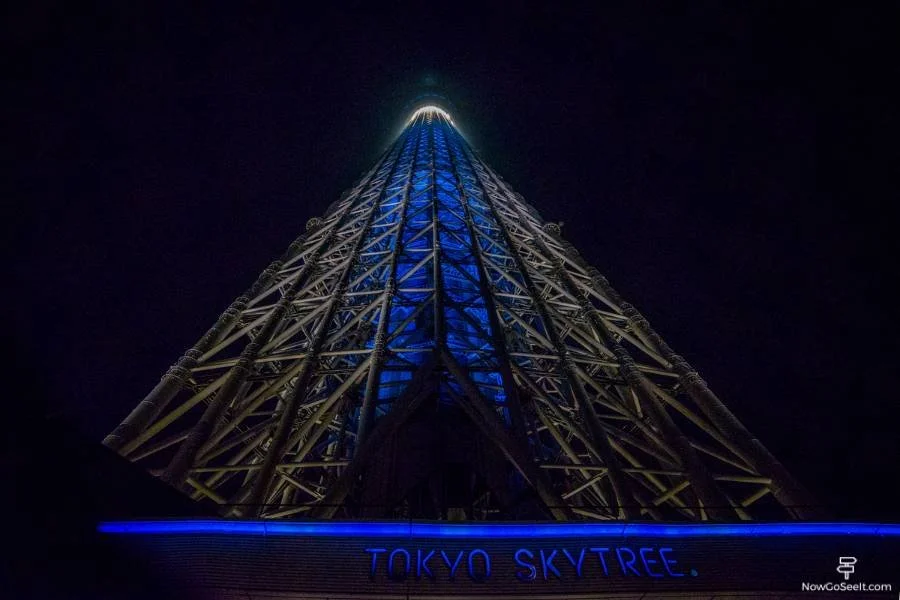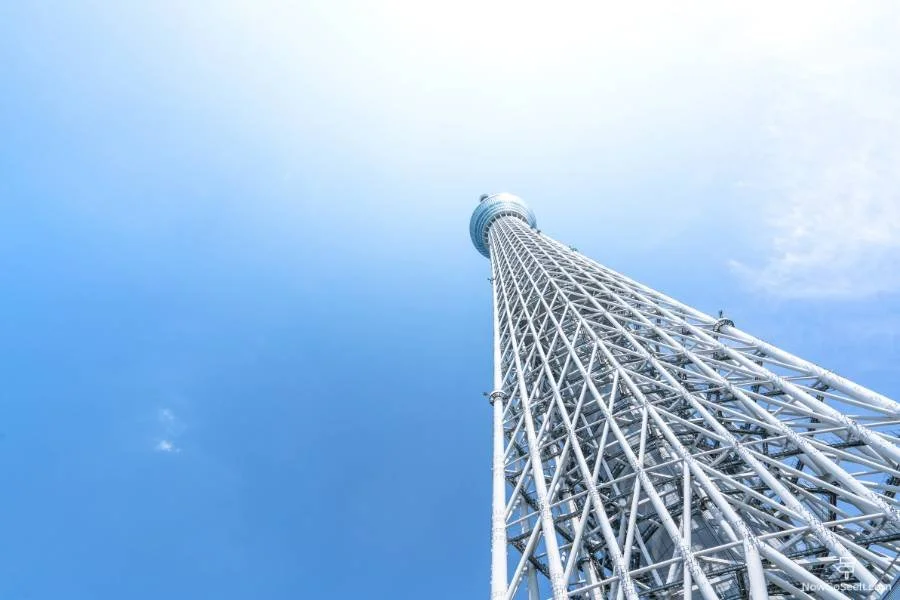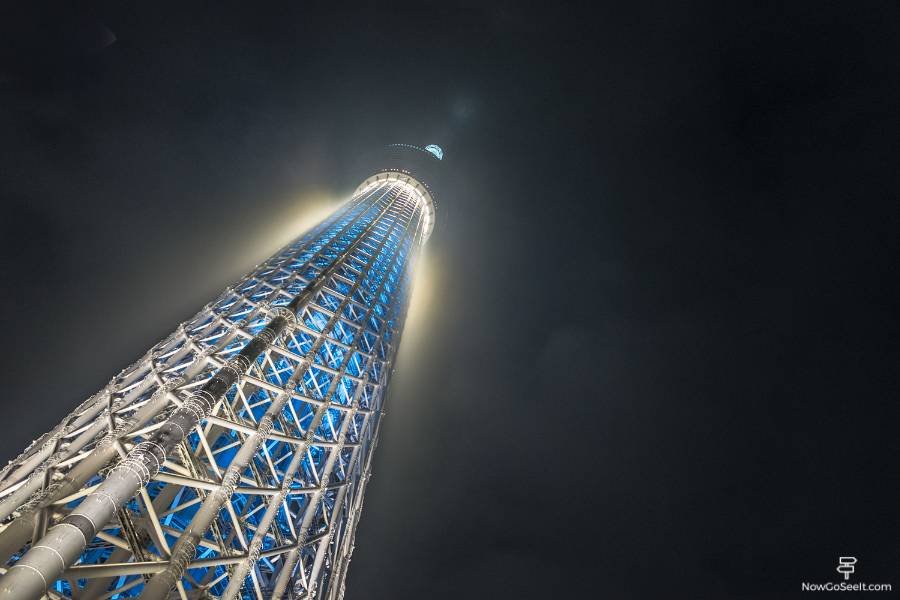Tokyo Skytree Guide: Tokyo Skytree Price, Tickets, and More
Now Go See It is reader-supported. When you buy through links on our site, we may earn an affiliate commission.
The World’s largest tower is one of the most popular tourist attractions in Tokyo. The views, especially at night, are one of a kind.
A visit to Tokyo Skytree is one of the top things to do in Tokyo. Check out our long list of 50 Things To Do in Tokyo for more great ideas.
Visiting Tokyo Skytree (Jump To):
Tokyo Skytree History
The Tokyo Skytree is a prominent landmark in Tokyo. Visitors flock to the tower daily for the epic city views as well as the chance to climb the tallest tower in the world.
The idea for a new tower to replace the aging Tokyo Tower was proposed in the early 2000s. The concept was to create a modern communications and observation tower that could handle the increasing demand for digital broadcasting and telecommunications in Tokyo.
The design for the Tokyo Skytree was chosen through a competition, and the winning design was created by the architectural firm Nikken Sekkei. Construction began in 2008, and it was completed in 2012. The tower's distinctive design features a futuristic, lattice-like structure that combines traditional Japanese aesthetics with modern engineering.
Tokyo Skytree was officially opened to the public on May 22, 2012. Its primary purpose is a communications tower, broadcasting television and radio signals to the Greater Tokyo Area. However, visitors and residents have fallen in love with the iconic tower. Visits to the observation decks and various entertainment and retail facilities are some of the most popular things to do in Tokyo.
The tower features two observation decks: the Tembo Deck at 350 meters (1,148 feet) and the Tembo Galleria at 450 meters (1,476 feet). These decks offer panoramic views of Tokyo and the surrounding areas. Tokyo Skytree quickly became a popular tourist attraction, drawing visitors from both Japan and around the world.
Tokyo Skytree also holds cultural significance. It is often illuminated with different colors to mark various events and holidays. Its height of 634 meters (2,080 feet) was chosen to reference the old name of Tokyo, Edo, and the height is considered auspicious in Japanese culture.
The Tokyo Skytree has become an iconic symbol of Tokyo and a modern addition to the city's skyline. It has played a vital role in the city's telecommunications infrastructure and has also contributed significantly to the tourism and economy of the region.
What You Need To Know
Official Site: Tokyo Skytree (English)
Map: Google Maps
Hours: Daily 10 am - 9 pm
WiFi: Free WiFi (with registration) on the TOBU Free WiFi Network.
Tickets: Available on-site, in advance at the above website, or via our partners at GetYourGuide.
How To Get to Tokyo Skytree
There are several convenient ways to get to the Tokyo Skytree from different parts of Tokyo. When planning your route, consider using navigation apps like Google Maps or Apple Maps for the most up-to-date and accurate directions. Public transportation in Tokyo is well-connected and efficient, so you have a variety of options to choose from based on your location and preferences.
Take the Train or Subway to Tokyo Skytree:
Tobu Skytree Line
Take the Tobu Skytree Line Line to the "Tokyo Skytree Station.” This station is directly connected to the Tokyo Skytree complex.
Tokyo Metro Hanzomon
Take the Tokyo Metro Hanzomon Line to the "Oshiage Station." This station is also directly connected to the Tokyo Skytree complex.
Ginza Line
Take the Tokyo Metro Ginza Line to "Asakusa Station" and transfer to the Tobu Skytree Line, which will take you directly to "Tokyo Skytree Station."
Toei Asakusa Line
Take the Toei Asakusa Line to "Oshiage Station," which is directly connected to the Tokyo Skytree complex.
Other Options:
Skytree Shuttle
The Skytree Shuttle is a no-transfer needed bus. This is a great option for people visiting Tokyo for the first time, or those uncomfortable navigating the subway system.
Direct busses are available from Tokyo Station, the Ueno-Asakusa Area, Haneda Airport, and Tokyo Disney Resort.
Tickets are just ¥220 (about US $1.50).
More information can be found here.
Taxis/Ride-Sharing
Taxis and ride-sharing services like Uber are available in Tokyo and can take you directly to the Tokyo Skytree.
River Cruises
Some river cruises along the Sumida River offer a scenic way to reach the Tokyo Skytree. There are disembarkation points near the tower.
By Car
Parking is available on-site. Hours for the parking structure are 7:30 a.m. to 11:00 p.m. (With last entry possible at 10:00 p.m.) Parking rates are ¥350 (US $2.40) per every 30 minutes.
Map: Google Maps
Please note that the parking structure is closed on weekends and holidays from 7:30 a.m. to 10:00 a.m. to help alleviate traffic congestion in the area.
Parking validation is available from purchases at Tokyo Solamachi and Tokyo Mizumachi.
One hour free with a combined purchase totaling over ¥3,000 (about US $21)
Two hours free with a combined purchase totaling over ¥5,000 (about US $34)
Three hours free with a combined purchase totaling over ¥7,000 (about US $48)
Handicapped parking is available, but may be limited during peak times
Electric Vehicle charging is available at the rate of ¥350 per 30 minutes (US $2.40)
ad:
How to Get to Tokyo Skytree Ticket Counters
From Oshiage Skytree Station: (Tokyo Metro Hanzomon / Toei Asakusa line)
Watch this route on YouTube.
Exit the station toward Tokyo Skytree Town signs.
Take the escalators to floor 4F. (There will be 5 escalators to ride)
For those with mobility issues elevators are available to floor 4F. The elevators are located to the left of the first escalator.
Follow the signs through the shops (there will be three turns)
Exit the shopping mall onto the outdoor space.
Keep left toward the tower (Now is a great time to look up!)
Enter the doors under the “Main Entrance” sign.
follow the white arrows on the floor to the ticket counter. There is a huge Tokyo Skytree Tickets sign above it.
From Tokyo Skytree Station: (Ginza Line / Tobu Skytree Line)
Watch this route on YouTube.
Exit the train station to street level.
Take the up escalator near the Family Mart convenience store.
To find the elevators walk into the tunnel that runs parallel to the train tracks. The elevators will be on your right after the stairs but before the escalator. Take the elevator to floor 4F.
Ride four escalators until you reach floor 4F.
Turn left and continue on the outdoor promenade.
turn right at the end of the walkway. (Look up and see the glorious tower)
Continue walking, the entrance to the building will be on your right.
Enter the doors under the “Main Entrance” sign.
follow the white arrows on the floor to the ticket counter. There is a huge Tokyo Skytree Tickets sign above it.
Tokyo Skytree Price
There is much to consider when planning your visit to the Tokyo Skytree. The price of your ticket will depend on the experience you would like to have during your time at the iconic tower.
There are two different ticket options. Prices for advance online tickets are discounted. Same-day tickets are also available.
We will fully explain the experiences below, but here is the price breakdown. You can easily buy tickets online at our partner Get Your Guide.
Advance online Ticket:
Visit the Tembo Deck Only: ¥1,800 (about USD $12.50)
Combo Tembo Deck and Tembo Galleria: ¥2,700 (about USD $18.50)
Same-Day Ticket:
Visit the Tembo Deck Only: ¥2,100 (about USD $14.50)
Combo Tembo Deck and Tembo Galleria: ¥3,100 (about USD $21.50)
How High Do You Want to Go?
View Tokyo Skytree From Below
Floors 1F, 4F, & 5F
For visitors who wish to experience the tower from below looking up, you can visit the base of the tower. On floor 1F or 5F, you can visit the Tokyo Skytree Shop for souvenirs and gifts commemorating your visit. On floor 4F you’ll find the Skytree Archives a gallery filled with displays featuring the history of the area. There is also an impressive 8K video presentation. Visiting the base of the tower is completely free.
Tokyo Skytree Tembo Deck
When viewing the Tokyo Skytree from afar, the Tembo deck is the large ribbon that surrounds the building at about 2/3 the way to the top of the tower. Located 350 meters from the ground the Tembo deck includes floors 340 to 350. There are three floors for visitors to explore with escalators connecting the floors. (There are also elevators available for wheelchairs and others with mobility issues).
Floor 350
The elevator from floor 4F will drop you off at Floor 350. You will work your way down as you explore. When you exit the elevator you will first be struck by the 360-degree view of Tokyo surrounding you. The vast beautiful city seems to go on forever around you. Those lucky enough to visit on a clear day may even have the chance to see Mt. Fuji in the distance.
This floor is home to the Skytree Round Theatre, a nighttime-only continuously running presentation of images on the walls and windows. There are two high-definition digital telescopes on this floor. Visitors can use them to zoom in on various spots on view from the tower. You’ll also find one of two Skytree Cafes offering light bites and drinks. This floor also has a commemorative photo spot where a professional photographer will take your photo. Photos are printed and presented in a commemorative keepsake holder and are available for purchase upon exiting. Finally, there is also a ticket booth to buy last-minute tickets to the Tembo Galleria. (More on that below)
Floor 345
You’ll take the escalator down to Floor 345. Here you will find Skytree Shop, where you can find one-of-a-kind souvenirs. This is also home to Skytree Restaurant 634 (more on that below). A fun activity on this floor is the ability to send a postcard to loved ones from the Skytree Post. It’s a mailbox shaped like the Skytree. You can buy postcards and an official commemorative postage stamp at the Skytree Shop.
Floor 340
The final floor to explore of the Tembo Deck includes another Skytree Cafe and an additional commemorative photo spot. Large windows continue to give visitors memorable views of the surrounding skyline.
A popular spot for the bravest visitors is the Tokyo Skytree Glass Floor. This free attraction allows you to put your feet on some (thick) glass and peer down at the spiral steel framework leading all the way to the ground below.
This floor is also where you will find the elevator that takes you back to the ground level. The elevator often has a short wait. The tour concludes by dropping you off at Floor 5F.
Tokyo Skytree Tembo Galleria
This is truly an amazing and immersive experience. For sure it is one of the best things to do in Tokyo. On our first visit to Tokyo, we only went to the Tembo Deck. I’m so glad we decided to go all the way to the top on a second visit.
The Tembo Galleria is the highest point you can visit on the Tokyo Skytree, everything higher is a communications antenna. When you view the Skytree from afar the Tembo Galleria is the final band at the very top of the tower.
Floor 445
The elevator drops you off at floor 445. Here you have the opportunity to take a commemorative photo with a professional photographer which can be purchased and picked up same day. (It also includes a digital version for instant sharing).
A slanted walk will take you all the rest of the way to the top. They call this the “air walk.” The white walls and window frames seem to disappear around the massive windows. The slowly sloped walk to the top gives you breathtaking views of the massive city of Tokyo surrounding you. It can feel like you’re walking on a cloud.
Along the way, there is another opportunity to gaze into a high-definition digital telescope. This is a fun way to see the ground below from a once-in-a-lifetime vantage point.
As you round the final bend you’ll reach the top.
Floor 450
You’ve managed to ascend an impressive 450 meters into the sky. You are now at the top of the highest tower in the world. You’re surrounded by some of the best views you may ever see.
Be sure to make your way to the official highest point you can access, Sorakara Point. Here you stand a full 451.2 meters from the ground. From here an elevator will take you down to the Tembo Deck where you can experience all three floors at that level.
Tokyo Skytree Facts
Before a visit, I like to know some interesting facts about the destination. Tokyo Skytree has no shortage of amazing statistics!
Height: The Tokyo Skytree is one of the tallest structures in the world. It stands at 634 meters (2,080 feet) tall, making it the tallest tower and second tallest structure globally.
Lighting: The Skytree's illumination changes with the seasons and events. It's known for its dynamic lighting displays on various occasions, making it a prominent part of Tokyo's skyline.
Record Breaker: The Skytree holds several records, including the world's tallest freestanding tower and the second tallest structure after the Burj Khalifa in Dubai.
Symbolism: The Tokyo Skytree represents Japan's technological advancements and cultural heritage, showcasing the country's fusion of tradition and modernity.
Tokyo Skytree Restaurant
There is a restaurant on the 345th floor of Tokyo Skytree called Sky Restaurant 634. The clever name references the 634-meter height of the Tokyo Skytree.
Reservations are highly recommended and can be placed directly on their website or by phone. Reservations may be placed as far as 60 days in advance.
The restaurant offers a lunch and dinner service. Menus change regularly and are served prix fixe with some opportunities to make specific changes or selections. The food is best described as French-inspired tastes with Japanese refinement.
Sky Restaurant 634 Prices:
Lunch prices range from ¥ 8,000-¥ 11,000 (about US $55 - $75) per person. Lunch is served from Noon until 4 p.m. On weekends and holidays, lunch begins at 11:30 a.m.
Dinner ¥ 22,000-¥ 30,000 (about US $150 - $210) per person. Dinner is served from 5:30 until 9:00 p.m.
A few things to know:
Children under age 10 are not permitted for dinner, only for lunch.
Credit cards are accepted.
A ticket to the Tembo Deck is required to dine at the restaurant and is not included in the price.
Dress is smart casual; shorts, t-shirts, and open-toed sandals are discouraged.
Tokyo Skytree At Night
Visiting Tokyo Skytree at night is a truly captivating experience that offers a unique perspective of the city's skyline and the vibrant urban landscape of Tokyo. The twinkling of the city’s seemingly endless lights will be a memory you treasure.
Dazzling Illumination: Tokyo Skytree is adorned with colorful LED lights that create a stunning visual display against the night sky. The tower often changes colors, transitioning through various shades and patterns, making it a mesmerizing spectacle.
City Lights: Tokyo is known for its neon lights and bustling streets, and these elements come to life even more vividly at night. From the Skytree, you can witness the organized chaos of Tokyo's nightlife, with illuminated streets, bustling neighborhoods, and iconic landmarks like Tokyo Tower and Rainbow Bridge in the distance.
Quiet Serenity: Despite the hustle and bustle of the city, the observation decks at Tokyo Skytree offer a peaceful and serene atmosphere at night. It's a chance to escape the noise and chaos below and enjoy a tranquil moment high above the city.
Photography Opportunities: If you're a photography enthusiast, visiting Tokyo Skytree at night provides incredible opportunities to capture breathtaking shots. The tower itself, along with the stunning cityscape, serves as a perfect subject for nighttime photography.
It's important to note that Tokyo Skytree can get quite popular, especially during peak tourist seasons or holidays. To avoid long lines and crowded conditions, consider making a reservation or arriving early in the evening. Overall, visiting Tokyo Skytree at night offers a memorable and captivating experience that showcases the city's vibrant energy and modern aesthetics in a whole new light.
Don’t forget to also enjoy the Tokyo Skytree on other nights of your trip to Tokyo. It’s an important part of Tokyo’s skyline. As you continue your time in the city be sure to look up. As one of the world's tallest towers, it is easy to spot, especially when illuminated against the night sky. There is something special about seeing it towering over the city knowing that days before you were up there.
Tokyo Skytree vs. Tokyo Tower
Whether to visit Tokyo Skytree or Tokyo Tower depends on your preferences and what you're looking to experience. Both structures offer unique views and attractions. Here's a comparison to help you decide:
Tokyo Skytree:
Height: Tokyo Skytree is the taller of the two, standing at over 634 meters. It's one of the tallest towers in the world and offers spectacular panoramic views of the city and beyond.
Modern Architecture: Skytree has a contemporary and futuristic design, making it a popular choice for those interested in modern architecture.
Technology: Skytree boasts advanced technology, including high-speed elevators and interactive displays that enhance the visitor experience.
Shopping and Dining: The Tokyo Solamachi shopping complex is located at the base of the tower, offering a wide range of shopping and dining options.
Crowds: Due to its popularity, Tokyo Skytree can get crowded, especially during peak tourist seasons. It's advisable to book tickets in advance to skip long lines.
Tokyo Tower:
Tickets for Tokyo Tower are available from our partner Get Your Guide.
Iconic Landmark: Tokyo Tower is an iconic symbol of Tokyo and has a unique Eiffel Tower-inspired design. It has been a part of the city's skyline for decades.
Observation Decks: While Tokyo Tower is not as tall as Skytree, it still provides excellent views of the city from its two observation decks. The Main Deck and the Special Observatory offer different perspectives.
Classic Appeal: Tokyo Tower has a sense of nostalgia and history that appeals to those interested in vintage aesthetics and the history of Tokyo.
Location: Tokyo Tower is situated in the Shiba Park area, which is closer to some other popular attractions like Zojoji Temple and Shiba Park itself.
Crowds: While Tokyo Tower can also get crowded, it might be slightly less busy compared to Tokyo Skytree.
If you're interested in modern architecture, and cutting-edge technology, and don't mind larger crowds, Tokyo Skytree might be your preference. On the other hand, if you're looking for an iconic landmark with a classic feel and a bit more historical charm, Tokyo Tower could be your choice. Both offer fantastic views of the city. If you want my true opinion, I would say to do both!
Tokyo Skytree vs. Shibuya Sky
Shibuya Sky:
Location: Shibuya Sky’s location in the bustling Shibuya location makes it a great place to visit as part of the neighborhood. Shibuya has a more authentically Japanese feeling than the mall aesthetic at the Tokyo Skytree complex
Observation Decks: Rising just 230 meters into the sky, the height of Shibuya Sky is dwarfed by the observation decks at Tokyo Skytree. However, the open-air viewing area creates a different dynamic.
Chill Vibes: The rooftop deck has hammocks and areas to lay back to take in the view. The chance to just hang out on the viewing deck makes a visit to Shibuya Sky into an event rather than a view.
Tokyo Skytree Elevator
The Tokyo Skytree has four high0speed elevators that were manufactured by the Toshiba Corporation. The elevators hold the record of being the fastest-moving elevators in Japan at 600 meters per minute. They also travel the longest distance of any elevator in Japan at 464.4 meters.
Each elevator is uniquely themed to one of the four seasons (Winter, Summer, Spring, and Fall).
Tokyo Skytree Glass Floor
Tokyo Skytree's Glass Floor is a unique attraction located on the Tembo Deck. This attraction allows visitors to stand on a glass-floored section and look down at the ground far below, providing a thrilling and slightly nerve-wracking experience. Here's what it's typically like to stand on the Tokyo Skytree Glass Floor:
The glass used for the floor is designed to be transparent and strong enough to hold the weight of visitors. This transparency adds to the sense of being suspended in the air, as you can see everything directly below you.
Rest assured that the Glass Floor is designed with safety as a priority. It's built to withstand the weight of multiple visitors and is regularly inspected to ensure its structural integrity.
Tokyo Skytree Shopping: Tokyo Solamachi
At the base of the Tokyo Skytree, there is a shopping and entertainment complex called Tokyo Solamachi. This complex offers a wide range of shops, restaurants, and attractions. Tokyo Solamachi translates to English as Tokyo Skytown.
It is situated right at the base of the Tokyo Skytree. Once you’ve completed your climb to the top make sure to leave plenty of time for shopping. There is enough to see and do in the Tokyo Solamachi entertainment complex to fill a whole vacation in itself.
We advise waiting to do your shopping until after your visit to the top of the Skytree as it is quite inconvenient to carry your purchases throughout the multiple decks. If you’ve already loaded up on souvenirs, information about lockers is below.
Shops, restaurants, and attractions are always changing in a pulsing modern city like Tokyo. For more information and the most up-to-date information, please visit the Tokyo Solamachi Website (English).
Location:
Address: Google Maps
How to Get there: Tokyo Solamachi can be accessed via public transportation, busses, cars, and taxis using the same routes as outlined above for accessing the Tokyo Skytree.
Hours: Main opening hours are 10:00 a.m. to 9:00 p.m. The restaurant floors have extended hours from 11:00 a.m. to 11:00 p.m. Some stores may have different hours as well.
Best Stores to Visit at Tokyo Solamachi
Pokemon Center Tokyo Skytree Town
Located on Floor 4F.
A paradise for Pokémon fans with exclusive merchandise and various interactive experiences including photo opportunities and character meet and greets.
Uniqlo
Located on Floor 3F.
The Japanese clothing retail giant is known for its affordable and stylish clothing. Uniqlo has made its way into your local mall, but visiting this sprawling location helps you understand how it became a global brand. They offer exclusive merchandise. I got a really cool Skytree shirt on my visit.
Loft
Located on Floor 3F.
A popular Japanese variety store that offers an eclectic mix of items, including home goods, cosmetics, and quirky lifestyle products. This is a great place for sharable souvenirs for friends at home.
Rilakkuma Store
Located on Floor 3F.
This store is a haven for fans of the cute Rilakkuma bear character, offering plush toys, accessories, and other Rilakkuma-themed merchandise. Limited edition Rilakkuma items are among the most popular purchases.
Okashi Gaku
Located on Floor 1F.
This unique cake vending machine offers a variety of cakes served inside soda pop-shaped aluminum cans. Flavors include strawberry shortcake, melon shortcake, and chocolate bear.
Matsumoto Kiyoshi
Located on Floor 1F.
If you’re looking to bring home some prized Japanese skin care products a visit to this popular drugstore chain is necessary. They offer cosmetics, skincare products, toiletries, and health supplements.
Daiso
Located on Floor 4F.
A well-known Japanese 100-yen shop (aka dollar store) that sells a vast range of products, from kitchenware and home goods to stationery and toys, all at affordable prices. I guarantee you will find something here that you never knew you couldn’t live without.
Disney Store
Located on Floor 3F.
A magical store filled with Disney merchandise, and a great place to visit if your itinerary includes a visit to the Tokyo Disneyland Resort. Available items include toys, clothing, accessories, and collectibles featuring all your beloved Disney characters. If you’re a fan of the Duffy Bear character, this is a great place to stock up! Duffy is beloved throughout Japan.
Donguri Kyowakoku (Ghibli Store)
Located on Floor 2F.
A store dedicated to Studio Ghibli, offering merchandise featuring characters and artwork from classic Ghibli films like "My Neighbor Totoro," "Spirited Away," and "Princess Mononoke."
Kamakura Akimoto
Located on Floor 1F.
Featuring a variety of items preserved with traditional Japanese-style pickling practices. Sample are available!
Hello Kitty Japan
Located on Floor 4F.
A shop dedicated to the vastly popular Hello Kitty character. The store is loaded with exclusive merchandise and souvenirs. It’s a must-visit for fans of the brand.
Tower Knives Tokyo
Located on Floor 4F.
Japanese knives are renowned for their quality. This shop will pair you with the perfect knife for your hand and for any cooking technique. If you’re concerned about getting it back on the plane with you, see the amenities section below to learn about worldwide shipping.
Best Restaurants at Tokyo Solamachi
Tokyo Solamachi offers a diverse range of dining options, from casual to upscale restaurants. There is an endless supply of amazing things to taste, I hope you’re hungry!
Takoya Dotonbori Kukuru
Located on Floor 1F.
An implant from the Osaka region of Japan this shop sells mouthwatering takoyaki. The meatball-sized delights are made from rolled wheat flour and then are filled with minced octopus before being fried and covered in a special sweet sauce.
Takoyaki is on our list of the Five Things You Have To Taste in Tokyo!
Qu'il fait bon
Located on Floor 2F.
Serving the most gorgeous of tarts, Qu'il fait bon specializes in traditional Japanese fruits and flavors. A long line often forms outside the store as patrons wait to get their hands on one of these tarts. A popular choice is The yuzu cheese soufflé.
Miyatake Sanuki Udon
Located on Floor 3F.
Serving some of the bounciest udon noodles around, Miyatake Sanuki Udon imports its dough ingredients all the way from Kagawa Prefecture. This regional chain started with an original location way back in 1928.
Ramen Express Hakata Ippudo
Located on Floor 3F.
Another regional chain, Ramen Express Hakata Ippudo specializes in warm and delicious ramen. The chain is consistently awarded and talked about on Yelp and Trip Advisor. This is a sure bet for good, fast, and cheap ramen.
Saboten
Located on Floor 6F.
A popular dish in Tokyo is tonkatsu, breaded and fried pork cutlets. Saboten is famous for tonkatsu. The chain dates back to its founding in Tokyo in 1966. Since then restaurants have opened worldwide, sharing their delicious recipe with the world.
Hitsumabushi Nagoya Binchou
Located on Floor 6F.
Hitsumabushi Nagoya Binchou is known for its unique method of grilling eel without steaming. Typically served hot off the grill with a side of rice the bite has a crisp yet flakey consistency.
Rokurinsha Tokyo
Located on Floor 6F.
Lovingly known for having the longest line in Tokyo, Rokurinsha Tokyo is famous for its tsukemen. This is a unique ramen dish where cold noodles are served separately from a broth. To eat, you dip the cold noodles and slurp.
Kirby Cafe Tokyo
Located on Floor 4F.
Based on the beloved Nintendo character, Kirby Cafe Tokyo serves intricately designed kawaii dishes that will surely look amazing on your Instagram feed.
Yakiniku Jojoen
Located on Floor 30F.
Presenting the fun dining sensation of yakiniku. Here on the 30th floor, you can take in some great views while grilling your own meat at small grills located at each table. This is a fun and interactive dining experience.
Other Things to Do at Tokyo Solamachi
Planetarium Tenku
Price: ¥1,600 adults; ¥1,000 children
Website: Planetarium Tenku
Located on Floor 7F.
Planetarium Tenku is an immersive planetarium experience for astronomy enthusiasts. Top technology in sound, vision, and projection mapping is used to create amazing visual shows. Shows are always changing but typically feature astronomy themes with a backdrop of classical music or Japanese pop music. There is often an animated educational astronomy film for young children.
Sumida Aquarium
Price: ¥2,500 adults; ¥1,800 Age 15-17, ¥1,800 Age 6-14, ¥800 Age 3-5
Website: Sumida Aquarium
Located on Floor 5F & 6F.
This small aquarium has much to enjoy. While I wouldn’t list it as a must-see aquarium, it has plenty to see including a fun penguin swim tank and the chance to see fur seals. A highlight is Edorium, the unique goldfish exhibit.
Postal Museum Japan
Price: ¥300 adults; ¥150 youth
Website: Postal Museum
Located on Floor 9F.
A heaven for stamp collectors, the Postal Museum Japan houses the largest stamp collection in Japan. In addition to stamps, the collection includes postal machines, mailboxes, and mail carrier artifacts. The museum opened in 1902, moving to its current location in 2014.
These attractions and experiences add to the overall enjoyment of your visit to Tokyo Solamachi, making it more than just a shopping center and an excellent destination for a day of exploration and entertainment.
Tokyo Solamachi Floor Guide
Floor 1F: This indoor outdoor level is where you will likely start your visit if arriving by train or subway. Here you will find many small and affordable restaurants and cafes. Along the Station Street corridor, you will find authentic Japanese goods. This is also
Floor 2F: Home to the Fashion Zone, you will find many clothing stores with a heavy focus on women’s fashion. There are also sweet shops and drugstores. You will also find the massive local food hall/grocery store Food Marche.
Floor 3F: Home to one of the main food courts this floor is where you will find many of the above-listed restaurants plus so many more to choose from or to sample. Many clothing stores and character-themed shops are also here.
Floor 4F: The vast amount of Japanese souvenir shops are located on this level. Other character and clothing shops are also here to explore.
Floor 5F: Numerous play areas can be found here including an area for babies and for kids twelve and under. There is also a play area here for pets. For all ages, you will find a crane arcade zone.
Floors 6F and 7F: Here you will find the dining floors with nicer, sit-down style restaurants. There is a seemingly endless amount of tantalizing restaurants to choose from.
Floors 30F and 31F: A small collection of higher-end restaurants. The higher floor level makes for nice views while dining.
Tokyo Solamachi Amenities
Luggage storage: is available for a fee at SAGAWA EXPRESS located on floor 1F.
Coin lockers: of varying sizes are located throughout the complex on floors 1F through 4F. There are even refrigerated lockers available on floor 2F!
Shipping: They offer overseas shipping for souvenirs. You can also have your items show up at your hotel with their services. You can also have your items sent for pick up at Tokyo Station, Haneda Airport, or Narita Airport. This can save you the hassle of taking your shopping bags onto the often crowded Tokyo public transportation.
Meet Sorakara-Chan
You may see a friendly star-faced girl while you explore the Skytree area. This is Sorakara-Chan, the official character of Tokyo Skytree. She saw the Tokyo Skytree from her home in the stars and decided she had to come to visit.
You’ll see her on posters, stickers, and merchandise all around the complex. There’s even a statue of her! If you’re lucky you may even get to take a photo with her during a character meet and greet.
In Summary
Visiting Tokyo Skytree is one of the top things to do in Tokyo (check out our long list of 50 Things To Do in Tokyo). Climbing to the high viewing points will absolutely be one of the most memorable experiences during your trip to Tokyo.
The chance to dine, shop, and explore Tokyo Solamachi is an added perk to the destination.
This is a one-stop destination for shopping, dining, and entertainment, making it a popular choice for tourists exploring the Asakusa and Sumida areas of Tokyo.
Both locations offer a mix of traditional and contemporary Japanese experiences, making it a must-visit spot in the city.

